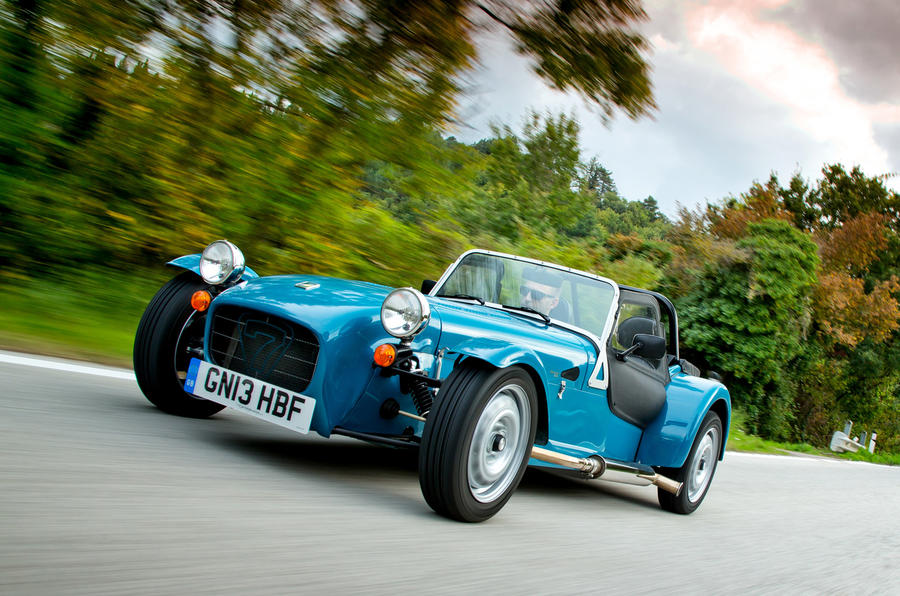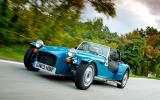What is it?
This is it the moment we’ll find out if we were right. Right to have been boring on about manufacturers not increasing power and speed, but reducing grip and weight, in order that we have more fun. This is the most significant embodiment yet of the idea. This is the Caterham Seven 160.
We’ve talked about it a lot already, and there are many things in the confirmed spec worth noting. Cubic capacity is just 660cc, in the form of a mildly blown Suzuki (car, not bike) engine. Suzuki installs it into various Kei cars and the like, and in rear-drive form in little delivery trucks (think Bedford Rascal a few generations on) it mates it to a five-speed manual gearbox with a live rear axle.
Caterham has bought the whole unit as a job lot, stopping to increase power from its standard 64bhp to 80bhp, made at 7000rpm, before slotting it into a Seven’s chassis.
In taking the drivetrain whole, the Caterham 160 utilises drum rear brakes too, and some 4.5J x 14in steel wheels that have a different stud pattern to other Sevens: thus making the option of bigger rubber impossible. Tyres are of just 155mm cross section, in 65 per cent profile. A sticky compound? Er, no. They are Avon ZT5s and cost less than £40 a corner.
All up, weight is just 490kg. The entry price is £14,995 in component form, £17,995 turnkey.
Like the old Caterham Classic you might remember, standard equipment is thin. Not as thin as it was: the only gauge fitted as standard to the Classic in the early 90s was a speedometer. These days you get a full complement.
But, stock, the 160’s aluminium body panels are left bare, the plastic ones (nose and all four wings) offered in just four basic colours. There are adjustable cloth seats, inertia-reel belts and a Moto-Lita steering wheel (our test car’s Momo, like the screen, is an option). And that’s it. At least you get a rev counter. There’s a payoff in that kerb weight is a claimed 490kg.
That’s not a lot for even a modest output like 80bhp to propel, so Caterham claims the 160 has a 0-60mph time of 6.5sec, and that it’ll run out of puff at 100mph.






















Join the debate
Add your comment
GIMMEE!
I want one of these for my daily driver.
Not at all convinced
Caterham can be like Porsche, they headline a low ball price but the cars can end up costing much more. Let's be serious and spec a 160 factory built, with windscreen and hood, heater, spare wheel and paint. That'll be 21,145, up 40% on 14,995 (+ another 400 if, like me, you are tall and want the lowered seats).
I know it can be silly to compare used car prices with new, but if you are buying a Seven you are buying a toy with disposable income, not something on a company lease that has to be sensible. The used Caterham market is so rich with alternatives that I wouldn't even consider a new 160.
Purely as an example, this is the first ad I found (offered at 13,995):
2005 Caterham Super 7, 1700 Super Sprint in aluminium and British racing green, polish revolution wheels, 5 speed gear box, full weather equipment - which has never been used. 1300 miles (YES - THIRTEEN HUNDRED MILES ONLY !!!)
from new, one owner, immaculate condition, complete with period Cosworth rocker cover, Weber carburettor, stainless steel side exit exhaust system. New Lotus 7 for a third of the cost of an original, history service book, heater and heated windscreen.
old isn't new!!
the old live 7 used a ford axle, from an escort (i think), and as such was far too heavy, but no different to anything else available. this axle isn't, and isn't, hence the report saying that it goes properly.
the 1.0 ecoboost has a cast iron block so it weighs pretty much the same as the 1.6 (aluminium block), and as such really is the wrong engine for a 7.
i've been waiting for this car for years!! a 7 was always "twice the fun of a ferrari, at half the speed", and that seems to have been forgotten a bit. this is all about feel and physics, and not loosing your license.
live axle
My experience of a live axled 7 with one of the first Academy cars was remarkably positive . In my case it used a Marina axle which was indeed very heavy. Despite that - and seeming to defy the laws of physics - it rode remarkably well and, dare I say it, actually felt quite sophisticated (!!) provided you didn't set the rear dampers too hard. Nor did it have the lack of directional stability that some comments seem to suggest. Having owned both a Europa before and an Elise since I have some elevated benchmarks to compare it with. I dismissed the 7 without even driving it when I bought the Europa - you live and learn! In the case of the 7 appearances couldn't be more deceptive.
Caterham have used both A frames and watts linkages for lateral location. I wonder if Caterham are now using a simpler - and less geometrically satisfactory method. Nearly any other method of lateral location - such as a Panhard rod - will produce some rear wheel steering.
Anyone know, the Caterham site is completely vague on the subject?